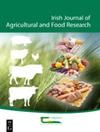爱尔兰肠道甲烷减排的解决方案
IF 1.4
4区 农林科学
Q3 AGRICULTURE, MULTIDISCIPLINARY
引用次数: 1
摘要
爱尔兰以草为基础的牲畜系统的效率可归因于高产量,低生产成本和低碳足迹相对于室内系统。甲烷(CH4)是一种强效温室气体(GHG),其中家畜生产中的肠道发酵是主要来源,直接负责57%的爱尔兰农业温室气体排放。有许多战略,包括饮食控制和育种举措,作为缓解反刍牲畜生产的潜在解决方案,已显示出有希望的结果。然而,大多数国际研究主要是在密闭系统上进行的。鉴于爱尔兰牲畜系统的经济可行性,在牧场上评估任何缓解方法都是至关重要的。如果没有合适的设备来测量放牧时甲烷的排放,这样的研究就无法完成。该审查记录了爱尔兰目前的知识能力(出版物和项目),并包括目前可用于进行研究的设备清单。本文确定了一些值得进一步研究的战略研究途径,包括育种倡议和饮食操纵。值得注意的是,爱尔兰似乎缺乏肠道CH4研究,因为从2016年到2021年,它占爱尔兰农业温室气体研究出版物的14%。确定了一些关键的基础设施缺陷,包括呼吸室(目前爱尔兰共和国没有呼吸室)和迫切需要更多基于牧场的GreenFeed™系统。这些缺陷需要得到解决,以使库存改进,研究进展和爱尔兰肠道CH4减排有效解决方案的发展。本文章由计算机程序翻译,如有差异,请以英文原文为准。
Solutions to enteric methane abatement in Ireland
The efficiency of Ireland’s grass-based livestock systems can be attributed to high outputs, low production costs and a low carbon footprint relative to housed systems. Methane (CH4) is a potent greenhouse gas (GHG) of which enteric fermentation from livestock production is a key source, being directly responsible for 57% of Irish agricultural GHG emissions. There are a number of strategies including dietary manipulation and breeding initiatives that have shown promising results as potential mitigation solutions for ruminant livestock production. However, the majority of international research has predominantly been conducted on confined systems. Given the economic viability of Irish livestock systems, it is vital that any mitigation methods are assessed at pasture. Such research cannot be completed without access to suitable equipment for measuring CH4 emissions at grazing. This review documents the current knowledge capacity in Ireland (publications and projects) and includes an inventory of equipment currently available to conduct research. A number of strategic research avenues are identified herein that warrant further investigation including breeding initiatives and dietary manipulation. It was notable that enteric CH4 research seems to be lacking in Ireland as it constituted 14% of Irish agricultural GHG research publications from 2016 to 2021. A number of key infrastructural deficits were identified including respiration chambers (there are none currently operational in the Republic of Ireland) and an urgent need for more pasture-based GreenFeed™ systems. These deficits will need to be addressed to enable inventory refinement, research progression and the development of effective solutions to enteric CH4 abatement in Ireland.
求助全文
通过发布文献求助,成功后即可免费获取论文全文。
去求助
来源期刊
CiteScore
2.50
自引率
20.00%
发文量
23
审稿时长
>36 weeks
期刊介绍:
The Irish Journal of Agricultural and Food Research is a peer reviewed open access scientific journal published by Teagasc (Agriculture and Food Development Authority, Ireland). Manuscripts on any aspect of research of direct relevance to Irish agriculture and food production, including plant and animal sciences, food science, agri environmental science, soils, engineering, buildings, economics and sociology, will be considered for publication. The work must demonstrate novelty and relevance to the field of research. Papers published or offered for publication elsewhere will not be considered, but the publication of an abstract does not preclude the publication of the full paper in this journal.

 求助内容:
求助内容: 应助结果提醒方式:
应助结果提醒方式:


